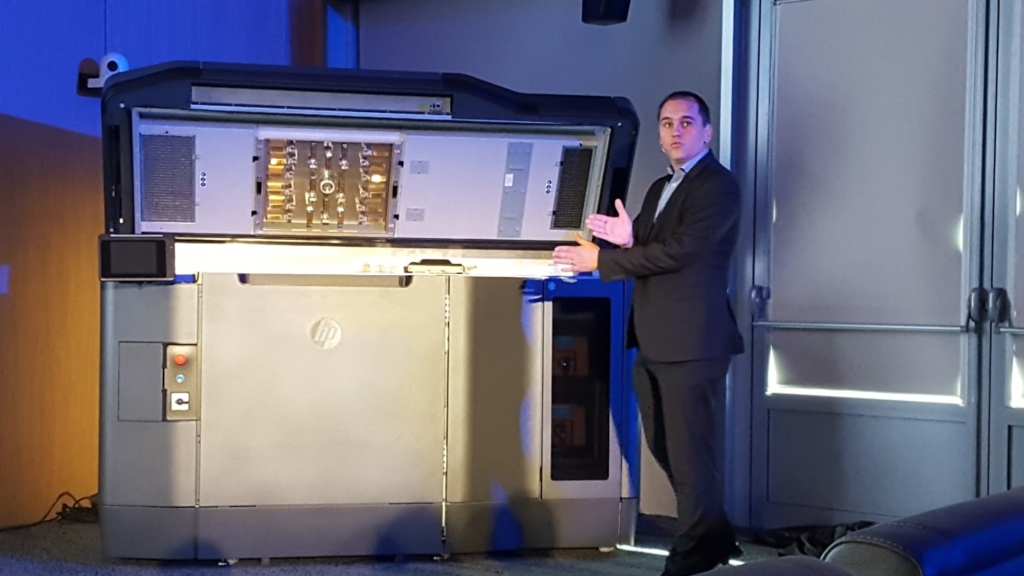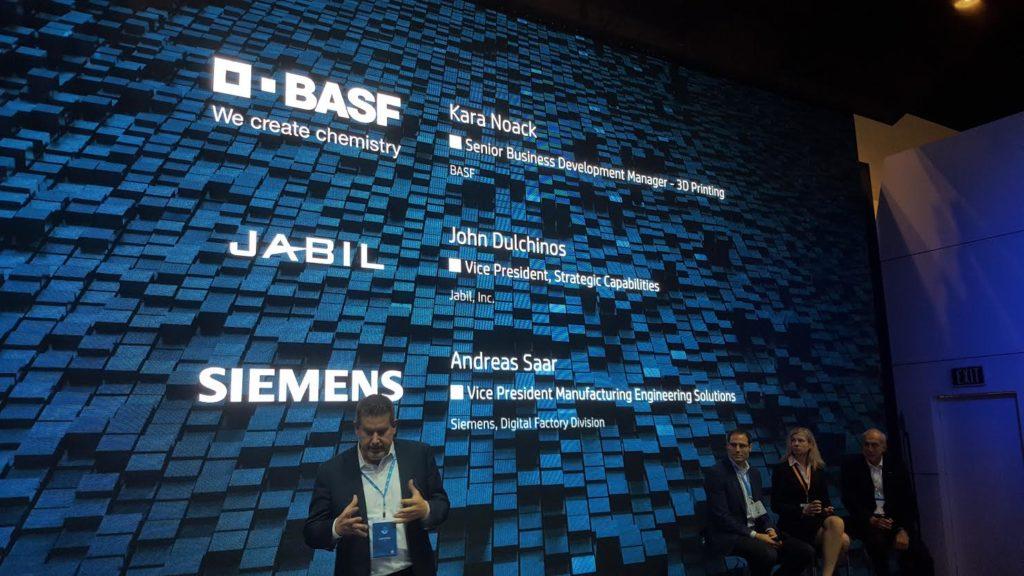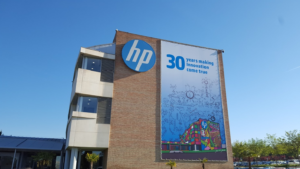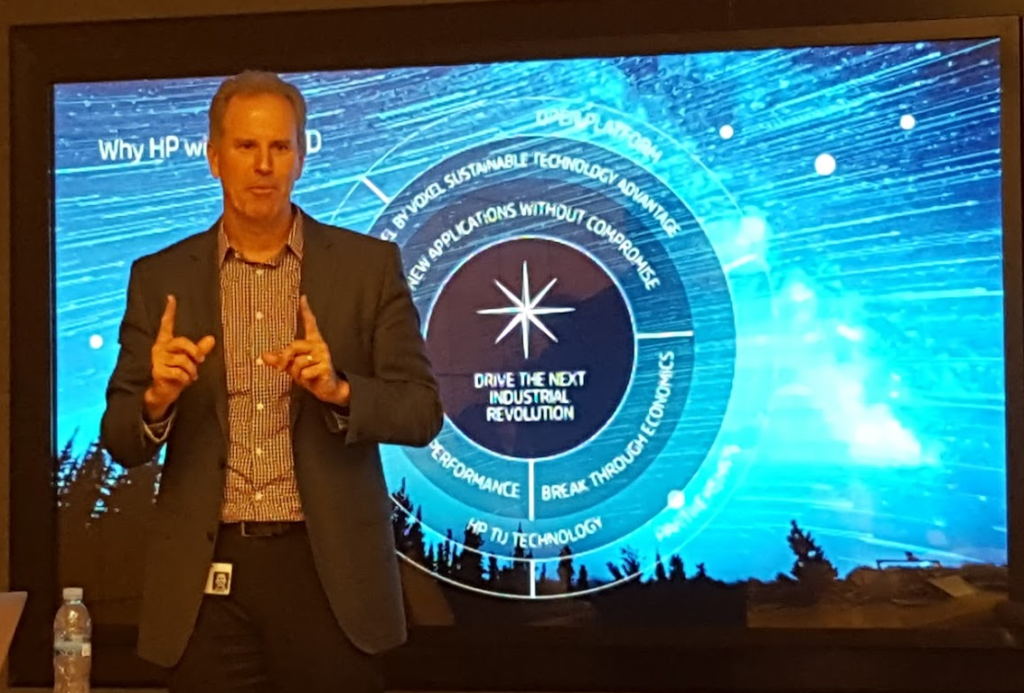Just outside of Barcelona, in Sant Cugat del Vallès, Spain, HP houses some incredible large-format printing equipment, with unbelievably huge digital web presses — and, deeper within their labs, some highly-anticipated 3D printers. At the beginning of May, a dozen of us were gathered to the site to preview the all-new Multi Jet Fusion 3D printing system, which HP initially announced way back in October 2014, and finally unveiled, ready for service, just last week at RAPID in Orlando.
“We brought you here not for the food or for the architecture but because this is the seat of our 3D printing,” Alex Moñino, Worldwide Marketing and Go To Market Director of HP’s 3D Printing Business, told the journalists and analysts gathered in early May at HP’s Barcelona site.
And while, admittedly, both the food and the architecture of Barcelona wowed us all, the star of the show was beyond a doubt the MJF 3D printing ecosystem, as the enthusiastic team at HP presented their creations to us with much fanfare (well, no trumpets sounded, but there were strobe lights). As the sheets were pulled off the machines for the first time before our eyes, the applause was genuine; the enthusiasm was contagious, and the shiny new machines certainly looked ready to produce. But first, we wanted to know more about how they had come to be, and the team gathered from HP were more than happy to fill us in on some of the background.
“Reinvention is who we are at HP — reinventing 3D,” Stephen Nigro, President, HP 3D Printing Business, told us. “We will lead the 3D Transformation over the coming decade and help drive, along with an ecosystem of partners, the next Industrial Revolution.”
By pre-announcing the 3D printer, and their entry into the 3D printing market, in 2014, with four primary promises, HP gave themselves time to identify customers and to “work and develop voxel-level innovation.” Promised in 2014, Nigro reminded us, was that their 3D printer would feature:
- Breakthrough performance
- Quality: precision and strength
- Breakthrough cost: both product cost and running costs
- Open platform approach
Applying four major lessons learned through HP’s decades-long leadership in the 2D printing market, Nigro told us that keys to becoming the leader in 3D include:
- Identifying and focusing on a mega-trend: in the case of 3D technology, this is the cloud
- Applications: rapid prototyping and final manufacturing production applications will be the change
- Standards: the 3MF Consortium and .3mf file format are a strong start in setting the standard
- Product: to get into final parts production, need to produce what looks like a final product; the actual, physical output is key here
“This market will be bigger than 2D printing, without a doubt,” Nigro told us confidently.
 And how are they going to do that? Significant study of the market and its needs, as it turns out, keying in on the size and projected growth in both prototyping (65% of the total market in 2020, with a 26% CAGR) and final production (with a whopping 37% CAGR). Focusing on the Analog-to-Digital Transformation that is driving all technological development, HP recognizes the critical nature of digitization; Nigro noted that “1s and 0s are changing industry, and 3D printing is a key enabler of digitization.”
And how are they going to do that? Significant study of the market and its needs, as it turns out, keying in on the size and projected growth in both prototyping (65% of the total market in 2020, with a 26% CAGR) and final production (with a whopping 37% CAGR). Focusing on the Analog-to-Digital Transformation that is driving all technological development, HP recognizes the critical nature of digitization; Nigro noted that “1s and 0s are changing industry, and 3D printing is a key enabler of digitization.”
Key to HP’s digitization focus are two offerings: High Value and Economics.
High Value appeals to potential customers on both a business and personal level, offering personalization, with unique creations and mass customization possible. Small batch production tends to be key to customization, but bringing mass capabilities here would be a game-changer.
Economics in this sense focuses on the break-even point for short and mid production runs, and Nigro noted that that break-even point will be the key to production for 3D printing. To be faster, with less waste, as well as scalable and low risk, the system would need some enhanced production capabilities and to be very carefully set up in the market. As Ramon Pastor, Vice President and General Manager of HP 3D Printing, filled us in, three design parameters led the way in the invention of Multi Jet Fusion, since the 2012 decision to “unleash the power of additive manufacturing”:
- Speed – process layers in one pass
- Part performance – build functional parts, modify properties of material at the voxel level
- Economics – cut running costs by half
In regard to the first of these parameters, Pastor noted that one axis lays powder, and one axis lays agents. Common misconceptions the team has noticed and would like to be clear on are that this is not binder jetting, and this is not material jetting.
By leveraging more than 30 years of investments in 2D, the HP team is able to create the speed needed, and plans to every 18 months improve by double from the previous generation. With 1200 nozzles/inch, the MJF technology reaches voxel-level control — and in the future, will develop voxel transforming agents. The economics come in due to MJF’x 1000x light exposure, as compared to SLS techniques, which leads to a key factor: powder reusability. Additionally, by printing at 10x faster speeds, each printer can thus produce 10x more parts in its lifetime.
The intent in approaching the materials for HP’s system is, as Marketing Product Manager Paqui Lizana noted, that the materials used in the MJF system “will be ahead of all others.” The materials used in this ecosystem are intended to be “a step ahead of SLS materials.” With a current dimensional accuracy of 0.2mm and improving, Lizana told us, this system is moving quickly “from an art to a process.”
 Of the 134 parts in the printer, 66 of these are themselves 3D printed. One-third of these parts were printed because the costs made sense; a further third of them were printed to reduce the number of parts required, as 3D printing can reduce complex geometries into single functional parts; and the remaining third of these parts were printed to improve time to market. HP representatives noted that people move to 3D for a few factors: economic advantage, time, design for AM and personalization. One of the 66 parts of the printer that was 3D printed had previously been injection molded in 12 parts that were screwed together; a single 3D printed component replaced those 12 with the same properties and functioning.
Of the 134 parts in the printer, 66 of these are themselves 3D printed. One-third of these parts were printed because the costs made sense; a further third of them were printed to reduce the number of parts required, as 3D printing can reduce complex geometries into single functional parts; and the remaining third of these parts were printed to improve time to market. HP representatives noted that people move to 3D for a few factors: economic advantage, time, design for AM and personalization. One of the 66 parts of the printer that was 3D printed had previously been injection molded in 12 parts that were screwed together; a single 3D printed component replaced those 12 with the same properties and functioning.
In Orlando, the team at HP took up two huge booth spaces, ready to show off their take on the revolution (which, they noted, “is about to begin”). The VIP press conference featured a video taking us all (back) to Barcelona, and over to San Diego, where key members of the team introduced features and filled us in on their development. Dr. Sascha de Peña, HP technologist, introduced us to the materials side from Barcelona, while San Diego R&D Project Manager Geoff Schmid noted that the non-reactive materials used in MJF technology allow for material reusability.
We then toured the booths, getting a good look at the machines. Here they are (apologies for the sound; we were wearing special headsets tuned in to their mics, and they were broadcasting as well via Periscope):
Scott Schiller next reminded us that to engage the market, the key was listening and collaboration.
“The approach we like to take is one of humility, one of listening, one of collaboration,” Schiller told us.
He then introduced representatives from three key collaborators: Kara Noack, Senior Business Development Manager – 3D Printing from BASF; John Dulchinos, Vice President, Strategic Capabilities from Jabil; and Andreas Saar, Vice President Manufacturing Engineering Solutions from Siemens.
He asked each a few questions so we could hear about their parts in the development process. He began with asking why this technology was exciting to each:
Jabil: “We believe that this is the first technology to allow us to take 3D printing from prototyping to manufacturing.”
BASF: “MJF is exciting to us because we can customize properties at the voxel level. The speed and affordability broaden its applicability.”
Siemens: “We truly believe this is going to change how we do everything in the future. Digitization starts in design. Additive is a revolution by itself. HP will drive this industrial revolution.”
Fundamentally, Schiller asked next, what changes in the materials road map?
Siemens: “We can completely rethink how to design and engineer products. Designers don’t think on the voxel level. Siemens will follow and guide this road map to innovation.”
BASF: “This enables acceleration in innovation. With HP’s keen understanding of end applications, we can enable an innovative ecosystem to unlock production and take it to new levels.”
Jabil: “The only way 3D printing/additive manufacturing will scale to production is a broad ecosystem, and that’s what brought us to the table. It was this new business model, new cost model.”
Next to answer questions was Stephen Nigro, who fielded queries regarding materials costs (which they are not disclosing as of now, but will be “aggressive, lower price points, with a balanced business model as far as margins are concerned. The open model will be very different from HP’s ink model. Dropping price points will drive volume”), as well as Alex Moñino, who noted that the capabilities customers need to be served are brought in by a 3-in-1 structure providing hardware, materials, and support, and explained that they are still actively looking for partners.
Another question was posed regarding intellectual property and patents. See Nigro’s response below:
Key to HP’s vision for the future is a collaborative approach to an open platform, which they see as truly driving the proposed revolution.
“I can’t emphasize enough how this is driving the industry,” Nigro told us of the open platform approach. “We believe we are uniquely positioned in the market,” he continued, regarding their partnerships and extensive development efforts.
 In addition to taking us through the development process, in both Barcelona and Orlando the HP team emphasized that they are only just beginning.
In addition to taking us through the development process, in both Barcelona and Orlando the HP team emphasized that they are only just beginning.
The next steps in store for the MJF platform include enhanced materials offerings and capabilities, including full color printing as well as the ability to embed sensors and other components directly into parts.
Below is a look at an example of the latter, in which Dr. Sascha de Peña tested a link that provides immediate feedback about stresses:
This is an incredibly interesting series of developments for the additive manufacturing field. Whatever comes of HP’s promises as more companies partner and test the Multi Jet Fusion technology, and competitive entities respond to this thrown gauntlet, we’re certain to see huge developments and announcements continue. Stay tuned for more details and information, including an interview with collaborator Materialise, regarding HP’s announcement.
[All photos/videos taken on-site in Barcelona and at RAPID by Sarah Goehrke for 3DPrint.com]Subscribe to Our Email Newsletter
Stay up-to-date on all the latest news from the 3D printing industry and receive information and offers from third party vendors.
Print Services
Upload your 3D Models and get them printed quickly and efficiently.
You May Also Like
Consolidation in AM: How 2025 Is Shaping the Industry’s New Normal
The first half of 2025 has been marked by a clear shift in the additive manufacturing (AM) industry. Companies are no longer just focused on developing new tech by themselves....
Etsy Design Rule Change Reduces Selection of 3D Printed Goods
Online marketplace Etsy has implemented a rule change requiring all 3D printed goods on the site to be original designs. The update to the site’s Creativity Standards states, ¨Items produced using...
U.S. Congress Calls Out 3D Printing in Proposal for Commercial Reserve Manufacturing Network
Last week, the U.S. House of Representatives’ Appropriations Committee moved the FY 2026 defense bill forward to the House floor. Included in the legislation is a $131 million proposal for...
Transforming From Tourist to Native: Duro CEO Michael Corr Explains Why the Company Rebuilt its PLM Software on AI
In these early innings of the AI boom, many market analysts have expressed concern that AI spend has gotten too far ahead of the technology’s proven ability to deliver significant...




































